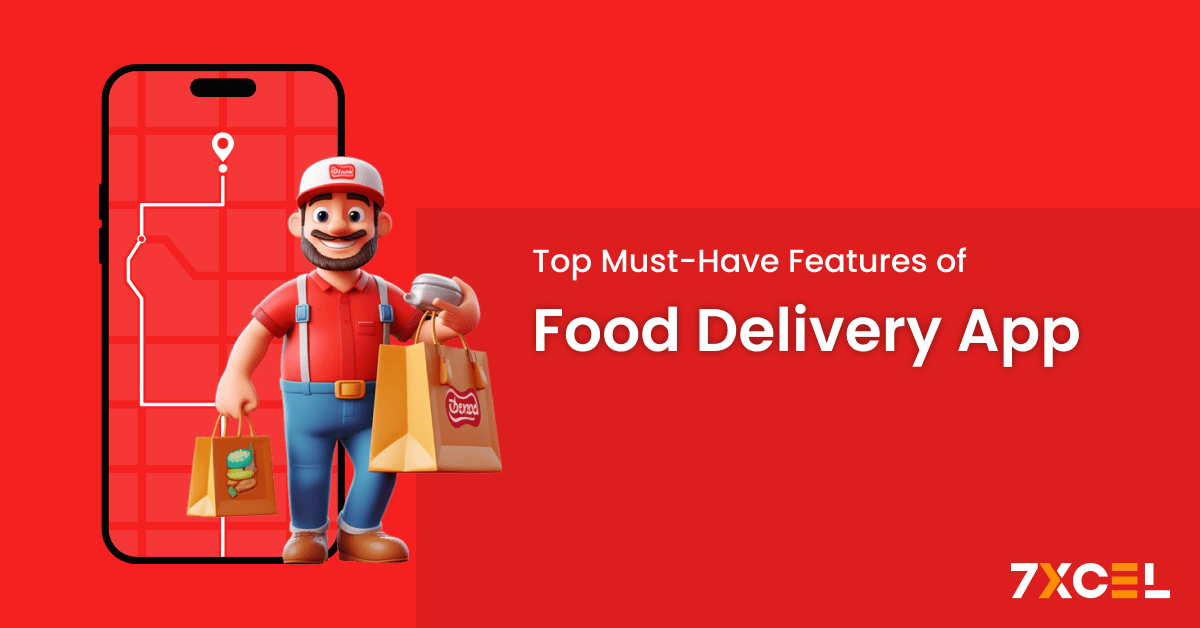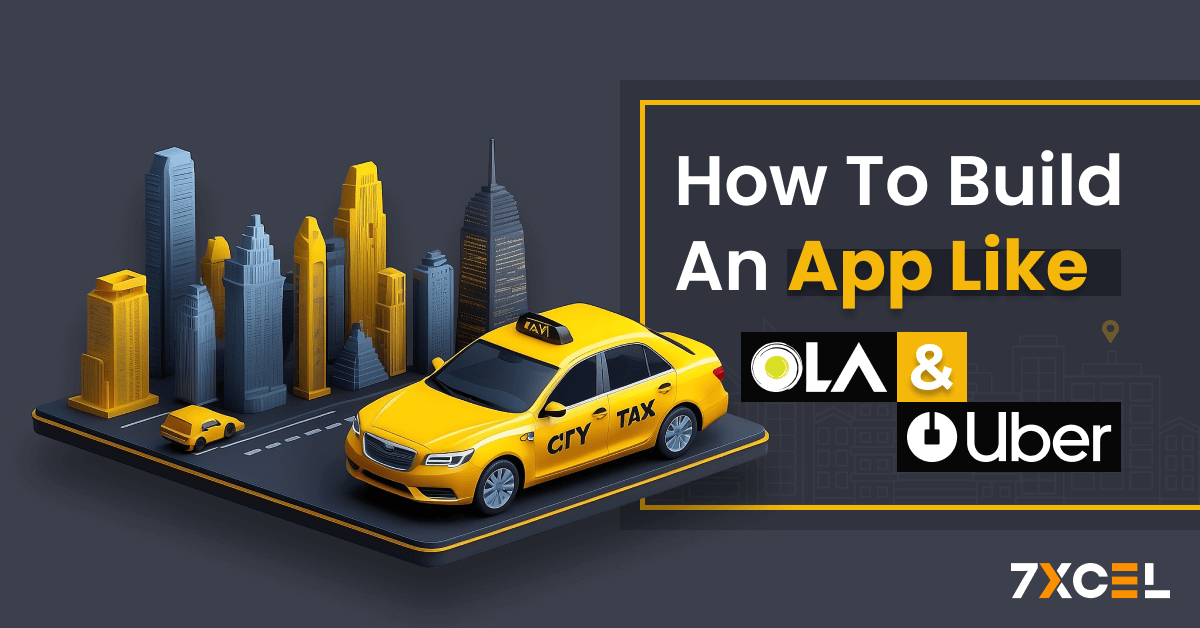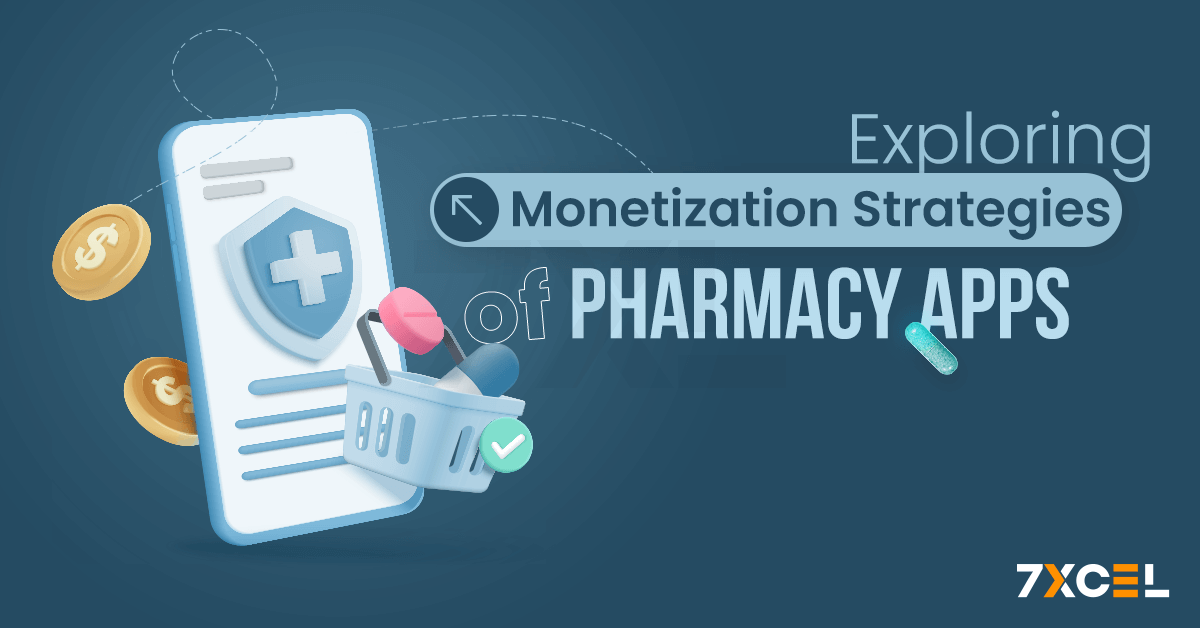Quick Summary:
Want to know what 2024 looks like for food delivery apps? These apps are poised to provide unparalleled convenience, personalization, and productivity as consumer expectations mature and technology evolves. Learn how new features and cognitive technologies with AI, ML, NLP will disrupt your next food ordering experience. Read on to learn more!
For the past couple of years, new factors of demand for convenience and operational economy have enabled the food delivery industry to go through tremendous growth and transformation. Looking to 2024, when the food delivery apps game is expected to become even fiercer to squeeze out competitors, the pressure will remain high on developers and service providers to find a point of innovation.
Food delivery applications must incorporate cutting-edge features to enhance user experience, boost productivity, and make use of the newest technology in order to stay competitive and adjust to shifting consumer behavior. This blog looks at the key aspects food delivery apps must have in 2024 to lead this ever-evolving market.
Food Delivery Market Overview
With a CAGR of 10.4% from 2021 to 2029, the worldwide food delivery market is estimated to reach $320 billion by 2029. Convenience, variety, and speedy service are becoming more and more desirable to consumers as on-demand services gain popularity. In such a competitive landscape, food delivery apps must incorporate cutting-edge features and leverage cognitive technologies like artificial intelligence (AI), machine learning (ML), and natural language processing (NLP) to meet evolving consumer expectations.
Key Statistics of Food Delivery Market
- Market Growth: The report states that the size of the worldwide online meal delivery market was expected to reach at USD 221.65 billion in 2022 and is projected to grow at a CAGR of 10.3% between 2023 and 2030.
- User Preferences: A survey by Deloitte found that 61% of consumers order food online at least once a week.
- Technological Integration: According to McKinsey, companies integrating AI and ML into their operations see a 15-20% increase in efficiency.
Essential Features for Food Delivery Apps in 2024
The food delivery industry continues to evolve, driven by technological advancements and changing consumer expectations. To remain competitive & meet the demands of modern users, food delivery apps like ubereats must integrate a range of innovative features. These features enhance the user experience, improve operational efficiency, and ensure security and convenience. Here the breakdown of important features:

1. User-Friendly Interface
A user-friendly interface is crucial for retaining users and ensuring a smooth ordering experience. It helps keep users engaged and makes the app accessible to a broader audience.
Intuitive Design
A clean, intuitive interface ensures users can easily navigate the app, browse menus, and place orders without any hassle. A simple and visually appealing layout keeps users engaged and reduces the learning curve.
Personalized Experience
Customer happiness and loyalty are increased by features that let consumers save preferred restaurants, personalize their accounts, and rapidly reorder previous meals. Personalization can make users feel valued and understood, driving repeat business.
2. Advanced Search and Filtering
Advanced search and filtering options are essential for helping users find exactly what they’re looking for quickly and efficiently.
Smart Search
Enable users to search for restaurants or dishes using keywords, cuisine types, dietary preferences, and specific ingredients. By providing accurate results, this function enhances the user experience and saves time.
Filter Options
Provide robust filtering options that allow users to narrow down their choices based on ratings, delivery time, price range, and more. This enhances satisfaction by making it easier to find suitable options.
3. Real-Time Order Tracking
By providing customers with up-to-date order progress information, real-time order tracking increases openness and optimizes user experience.
GPS Integration
Real-time tracking allows users to monitor their order from preparation to delivery. GPS integration provides accurate updates on the driver’s location and estimated delivery time, enhancing transparency and trust.
Notifications
Throughout the order process, from confirmation to delivery, notify users via push notifications. This keeps users engaged and reduces uncertainty, making the delivery process more predictable.
4. Multiple Payment Options
Offering secure and diverse payment options is crucial for user convenience and trust.
Secure Transactions
Offer a number of payment options, such as online banking, digital wallets, and credit/debit cards. Ensuring secure transactions builds user trust and encourages more frequent use.
Contactless Payments
Integrate contactless payment options to enhance user convenience and safety, especially important in today’s health-conscious environment. This feature ensures that users can make payments safely and quickly.
5. Seamless Ordering Process
An efficient and customizable ordering process keeps users coming back and ensures a hassle-free experience.
Easy Customization
Permit consumers to add special instructions to their instructions for preparation, preferred delivery time, and contactless delivery options. Customization options ensure that user needs and preferences are met.
Quick Reorder
Enable users to reorder their favorite meals or past orders with a single click, making the ordering process faster and more convenient. This feature enhances user satisfaction by simplifying the reordering process.
6. Ratings and Reviews
Ratings and reviews help maintain quality and build trust among users by providing transparent feedback on service and food quality.
Customer Feedback
Implement a system where users can rate their delivery experience and leave reviews for restaurants and drivers. By allowing users to base their judgments on the experiences of others, this promotes quality and trustworthiness in the platform.
Response Management
Allow restaurants and delivery partners to respond to reviews, fostering better communication and resolving issues promptly. This feature shows that the platform values feedback and is committed to improving service quality.
7. Loyalty Programs and Promotions
Loyalty programs and promotions can drive user engagement and retention by rewarding regular customers.
Rewards System
Provide a rewards program where customers can exchange their points for discounts or freebies. They will receive points for every order they place. Loyalty programs encourage repeat business and increase user retention.
Exclusive Offers
Provide exclusive offers and promotions for loyal customers, encouraging repeat business and increasing user retention. Tailored promotions can make users feel valued and appreciated.
8. Multi-Language Support
Multi-language support can expand the app’s user base and improve accessibility, catering to a diverse audience.
Language Options
Offer multiple language options to cater to a diverse user base. Localization of content improves accessibility and user satisfaction by making the app usable for non-native speakers.
Cultural Customization
Adapt the app’s content and user interface to suit cultural preferences and norms in different regions. This enhances the user experience by providing culturally relevant content.
9. Customer Support
Providing robust customer support is essential for maintaining high user satisfaction and trust.
24/7 Support
Provide round-the-clock customer support through various channels like chat, email, and phone. Quick and efficient customer service enhances user trust and satisfaction by ensuring help is available whenever needed.
In-App Help Center
Include an in-app help center with FAQs, order tracking, and issue resolution options to assist users without needing direct support. This feature empowers users to find solutions independently.
10. Sustainability Features
Sustainability features can attract environmentally conscious consumers and demonstrate a commitment to social responsibility.
Eco-Friendly Options
Offer users the option to choose eco-friendly packaging or contribute to sustainability initiatives. Highlight restaurants that prioritize sustainable practices, attracting environmentally conscious consumers.
Carbon Footprint Tracking
Allow users to track the carbon footprint of their orders and provide suggestions for reducing environmental impact. This feature can educate users on their environmental impact and encourage more sustainable choices.
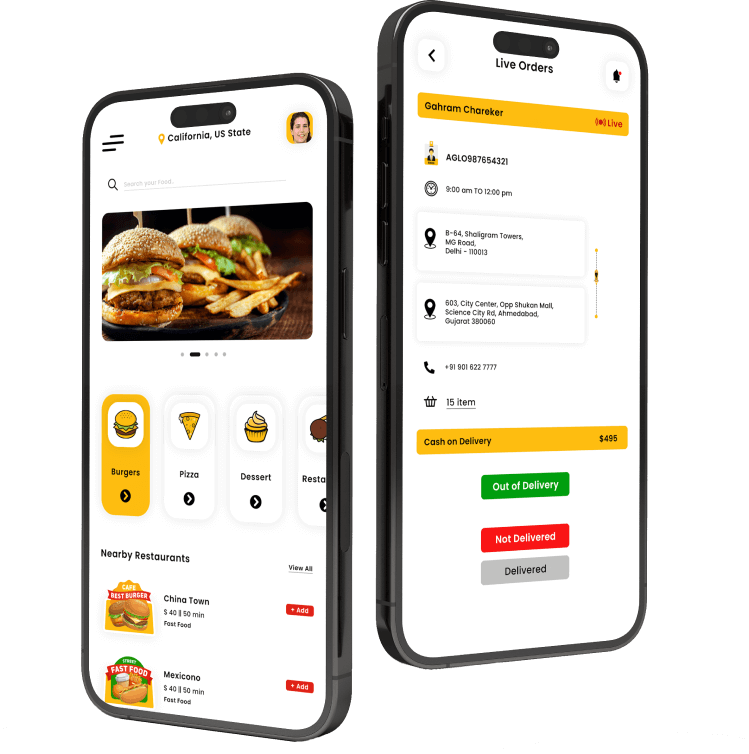
Interested to develop a standout food delivery app?
At 7xcel, our on-demand food delivery app development services empower food business owners to rapidly enhance brand visibility and boost sales.
Technical Features of Food Delivery App
To stay competitive, food delivery apps must integrate advanced technical features. Key elements include cloud integration, API connectivity, real-time analytics, AI, and robust security measures, enhancing performance, scalability, reliability, and user experience in 2024:
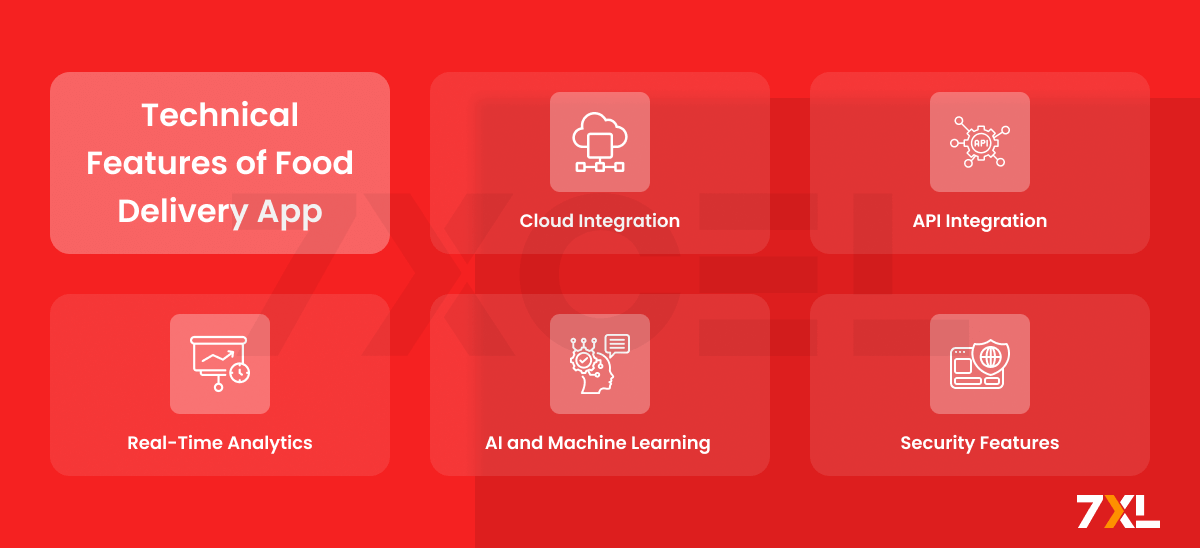
11. Cloud Integration
Cloud integration ensures that the app can handle increased traffic and data without compromising performance, offering scalability and reliability.
Scalability
Cloud integration ensures that the app can handle increased traffic and data without compromising performance. This is essential for scaling up operations seamlessly.
Reliability
Cloud services provide high availability and uptime, ensuring that the app remains functional even during peak times.
Data Security
Utilize cloud security features to protect sensitive user data, ensuring compliance with data protection regulations. This builds trust with users by safeguarding their personal information.
12. API Integration
API integration enhances the app’s functionality by connecting with various third-party services and systems.
Third-Party Services
To improve usability and usefulness, integrate your product with other services like social media platforms, mapping applications, and payment systems.
Restaurant Management Systems
Connect with restaurant management systems for real-time updates on menu changes, order statuses, and inventory management.
Logistics Partners
Integrate with logistics partners for efficient delivery management, real-time tracking, and optimized route planning.
13. Real-Time Analytics
Real-time analytics provide valuable insights into app performance and user behavior, guiding strategic decisions and continuous improvement.
Performance Monitoring
Implement real-time analytics to monitor app performance, track user behavior, and identify trends. This helps in making data-driven decisions for continuous improvement.
Custom Reports
Generate detailed reports on key metrics such as order volumes, delivery times, customer satisfaction, and revenue. These insights help in strategic planning and optimization.
User Behavior Analysis
Analyze user interactions to identify trends and improve the overall user experience. Insights from analytics can guide feature enhancements and marketing strategies.
14. AI and Machine Learning
AI and machine learning can provide personalized recommendations, dynamic pricing, and predictive analytics, enhancing the user experience and operational efficiency.
Personalized Recommendations
Use AI algorithms to provide personalized restaurant and dish recommendations based on user preferences and order history.
Dynamic Pricing
Implement dynamic pricing models that adjust delivery fees based on demand, time of day, and delivery distance, balancing cost efficiency for the business and affordability for users.
Predictive Analytics
Employ predictive analytics for demand forecasting, inventory management, and identifying potential operational bottlenecks.
15. Security Features
Robust security features ensure the protection of user data and transactions, building trust and compliance with regulations.
Data Encryption
Ensure all data transmitted between the app and servers is encrypted to protect sensitive information from unauthorized access.
Fraud Detection
Use AI to detect unusual patterns that may indicate fraudulent activities, ensuring the security and integrity of transactions.
User Authentication
Employ strong user authentication methods, such multi-factor authentication (MFA), to increase security and prevent unauthorized access.
Through the integration of these fundamental qualities, food delivery applications can maintain a competitive advantage in the constantly expanding food delivery market of 2024, while also improving user happiness and operational efficiency.
Leveraging Cognitive Technology in Food Delivery Apps
Cognitive technology, encompassing AI, ML, and NLP, can remarkably enhance the functionality and user experience of food delivery apps. Partnering with a specialized Food Delivery App Development Company can help you build a platform that effectively incorporates these advanced technologies.
These experts can assist in integrating features like personalized recommendations, real-time order tracking, and dynamic pricing, significantly improving user engagement and satisfaction. Here’s how cognitive technology can transform your food delivery app:
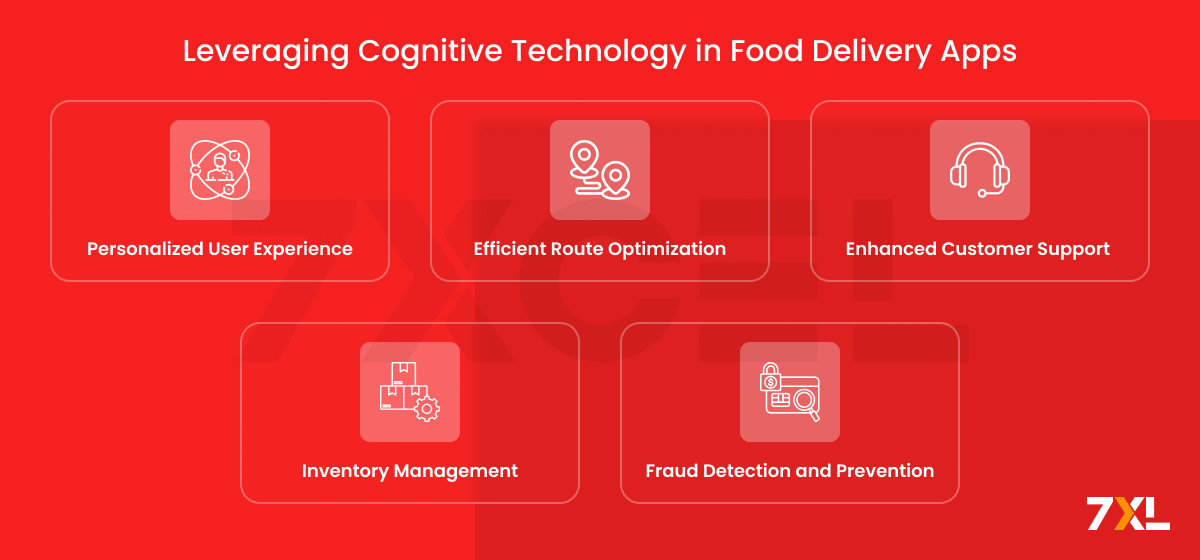
1. Personalized User Experience
AI algorithms can analyze user data to provide personalized recommendations, enhancing the overall user experience.
- Behavioral Analysis: Use ML to analyze user behavior and preferences, offering tailored food recommendations.
- Dynamic Content: Display personalized content, such as special offers and new dish suggestions, based on user interests.
2. Efficient Route Optimization
AI and ML can optimize delivery routes, ensuring faster delivery times and reducing operational costs.
- Real-Time Traffic Analysis: Use AI to analyze real-time traffic data and determine the most efficient delivery routes.
- Predictive Analytics: Predict peak order times and deploy delivery drivers accordingly to manage demand efficiently.
3. Enhanced Customer Support
NLP-powered chatbots can handle customer queries more effectively, providing instant and accurate responses.
- Automated Responses: AI chatbots can answer frequently asked questions, track orders, and resolve common issues without human intervention.
- Sentiment Analysis: Use NLP to analyze customer feedback and sentiment, helping improve service quality.
4. Inventory Management
AI can help restaurants manage their inventory more efficiently, reducing food waste and ensuring the availability of popular items.
- Demand Forecasting: Use ML algorithms to predict demand for various dishes, helping restaurants stock up accordingly.
- Automated Restocking: Integrate with suppliers for automated restocking based on inventory levels and predicted demand.
5. Fraud Detection and Prevention
AI and ML can enhance security by detecting fraudulent activities and preventing potential threats.
- Transaction Monitoring: Use AI to monitor transactions in real-time, flagging any suspicious activity.
- User Authentication: Implement biometric authentication methods, such as facial recognition or fingerprint scanning, to secure user accounts.
Future Trends in Food Delivery Apps
As technology continues to evolve, food delivery apps are expected to integrate more advanced features and capabilities. Here are some trends to watch out for:

1. Augmented Reality (AR) Menus
AR technology can provide an immersive experience by allowing users to visualize dishes before placing an order.
- 3D Dish Previews: Use AR to display 3D models of dishes, helping users make more informed choices.
- Interactive Menus: Create interactive menus that provide detailed information about ingredients, nutritional values, and preparation methods.
2. Eco-Friendly Delivery Options
With increasing environmental awareness, offering sustainable delivery options can attract eco-conscious consumers.
- Electric Vehicles: Use electric bikes and scooters for deliveries to reduce carbon footprint.
- Reusable Packaging: Promote the use of reusable and biodegradable packaging materials.
Conclusion
In 2024, the success of food delivery apps will hinge on their ability to innovate and adapt to changing consumer demands. By incorporating advanced features and leveraging cognitive technology, these apps can provide a seamless, personalized, and efficient user experience. As AI, ML, and NLP continue to evolve, their integration into food delivery apps will unlock new possibilities, enhancing every aspect of the service from order placement to delivery.
Food delivery apps that stay ahead of the curve by embracing these technologies and trends will not only meet but exceed customer expectations, securing their position in an increasingly competitive market.
